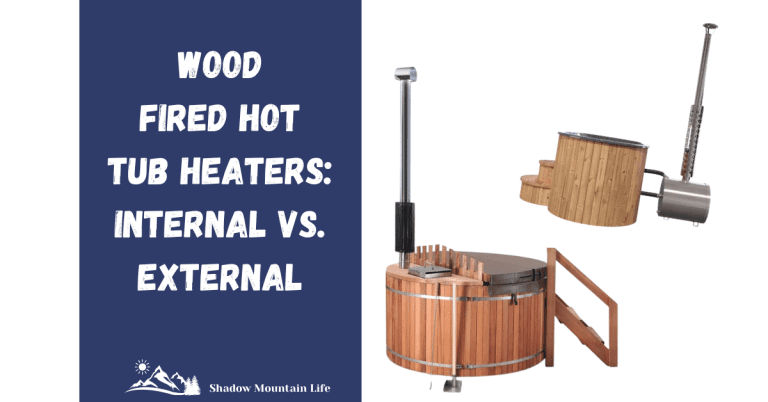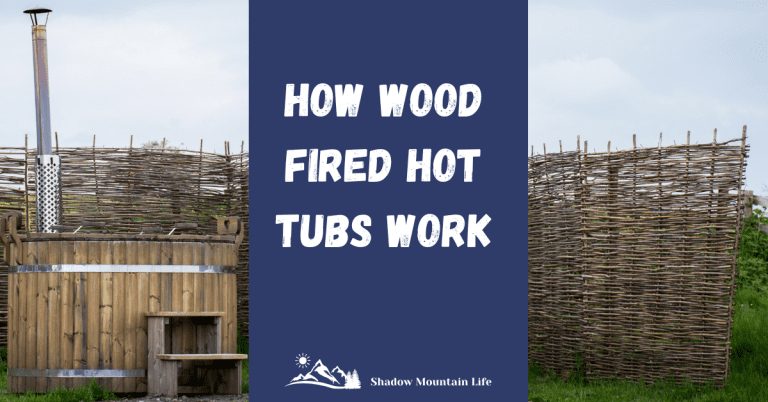Wood Fire Hot Tub versus Electric Hot Tub: Comparing Costs and Maintenance to Help You Decide Which is Best
If you are considering a hot tub, you may be weighing the choice of a wood fire hot tub versus electric hot tubs. If not, you should consider a wood fire hot tub!
Did you know that wood fire hot tubs have been used for over 1,000 years, with the first documented cases in Japan’s onsen culture? Today, they’re making a comeback as homeowners seek more sustainable and authentic spa experiences. But how do they stack up against modern electric hot tubs? I’ll walk you through everything you need to know about these two distinct approaches to outdoor relaxation, helping you make the perfect choice for your lifestyle and budget.
Medical Disclaimer: We are not doctors. The health information in the article is for informational and educational purposes only. Please consult your doctor or other healthcare professional when making medical decisions.
Affiliate Disclaimer: We may make a commission if you purchase something through our links. Thank you!

Initial Investment and Running Costs of a Wood Fire Hot Tub versus Electric Hot Tub
I’d initially assumed electric hot tubs were the more expensive option and this proved true as I’ll explain below.
I discovered that wooden hot tubs typically range from $4,500 to $8,000 for high-quality cedar models. Electric hot tubs, on the other hand, can run anywhere from $3,000 for a basic model to upwards of $20,000 for premium units with all the bells and whistles.
Installation Costs
Installation costs of the hot tubs were what really opened my eyes. For electric hot tub quotes, electricians were charging between $500 to $1,500 just to run the necessary 220V line and install the GFCI breaker. Plus, you might need to pour a concrete pad, which added another $500-1,000 to the project. Wood-fired tubs? No electricity required! And they basically just need a level surface, although crushed gravel or a concrete pad is ideal.
Monthly Costs
While splitting and stacking wood may not be everyone’s cup of tea, the monthly running costs of a wood fired hot tub are less than that of an electric tub. By using wood, you are not affected when electricity rates go up as well. You may spend about $20-30 monthly on wood for a wood-fired tub, depending on how often you use it and local wood prices.
Here’s a practical breakdown of the costs:
Electric Hot Tub (6-person):
– Average purchase price: $6,000-8,000
– Installation: $1,000-2,500
– Monthly electricity: $50-75
– Chemicals: $20-30/month
– Annual maintenance: $200-300
Wood-Fired Hot Tub (6-person):
– Average purchase price: $5,500-7,000
– Installation: $200-500
– Monthly wood costs: $20-30
– Chemicals: $10-15/month (little to no chemicals needed due to freshwater changes)
– Annual maintenance: $100-200
Long-term Cost Projection
One thing that really surprised me was the long-term cost projection. Over a 5-year period, a wood-fired tub could save us approximately $3,000 in operating costs compared to a similar-sized electric model. However, there’s definitely a trade-off in terms of convenience – you can’t just press a button and have hot water ready whenever you want it.
Potential Energy Savings and Efficiency
The biggest money-saving tip I can share? If you’re going the wood-fired route, build relationships with local tree services. You may be able to get your wood for free or cheap because usually they’d rather dump their clean hardwood at your place than pay disposal fees. For electric tub owners, investing in a good-quality cover and setting a timer to heat during off-peak hours can significantly reduce those monthly bills.
Remember though – these numbers can vary quite a bit depending on your location, energy costs, and wood availability. In areas with high electricity rates or easy access to wood, the cost difference becomes even more pronounced. Definitely do some local research before making your final decision.
It’s worth it to take the time to crunch the numbers beforehand save yourself from making an expensive mistake. The key is being honest with yourself about your priorities – are you willing to trade some convenience for lower running costs, or is the plug-and-play nature of an electric tub worth the extra expense?

Heating Time and Temperature Control of Wood Fire vs. Electric Hot Tubs
Average Heat-up Times for Both Types of Tubs
Wood-fired tubs typically take about 90 minutes-3 hours to heat from cold to a perfect 104°F. The trick is getting your fire rhythm right when heating the water. Start with a hot flame using smaller pieces of dry softwood, then switch to larger hardwood logs to maintain the temperature. Stop adding firewood before getting to your desired temperature so you don’t overshoot and get too hot. It’s a good idea to keep a bucket of cold water nearby just in case!
Electric tubs, though? They’re way more predictable but significantly slower. They consistently take 4-6 hours to heat from cold, but here’s the thing – once it’s hot, it stays at exactly the temperature you want. No checking the thermometer every 20 minutes like you need to do with a wood-burning setup!
Temperature Consistency and Control Mechanisms
Temperature control is where electric tubs really shine. You just set it and forget it, typically within 1°F of your target. With a wood fire tub, you must master the art of fire management. Too much wood? You’re cooking yourself. Too little? Hope you enjoy lukewarm baths! The temperature can swing 5-8°F during a single session if you’re not paying attention.
Impact of Outdoor Temperature on Heating Performance
One tip I’ve learned: for wood-burning tubs, start heating earlier than you think you need to, especially in winter. The ambient temperature makes a huge difference in heating time. Electric tubs aren’t as affected by outside temperatures thanks to their insulation, but they’ll still use more energy to maintain heat when it’s freezing outside.
Maintenance Requirements and Longevity
Both types of tubs require lifelong maintenance although the tasks vary per tub.
Maintenance Tasks for Both Types of Tubs
Depending on usage, drain and refill the wood fire tub every 2-3 uses. Since there’s no complex plumbing or jet systems, the maintenance is pretty straightforward – just a good scrub with natural cleaners and you’re good to go. The exterior cedar wood will need some love every year with a wood treatment to keep it looking nice.
Electric tubs, on the other hand, are more demanding with their daily chemical balancing act. Electric tubs require checking pH levels, sanitizer levels, and alkalinity at least 2-3 times per week. Plus, there’s the quarterly deep clean of the filters and annual replacement of the filter cartridges. Those fancy jets? They need periodic flushing to prevent biofilm buildup and bad smells.
When it comes to longevity, here’s the real scoop: A well-maintained cedar wood-fired tub can last 15-20 years, with maybe a liner replacement every 5-7 years. Electric tubs typically go for 10-15 years before major components start failing. The pump usually goes first (around year 7-10), and the heater element isn’t far behind.
The biggest maintenance tips? For wood-fired tubs, keep the water clean and the wood oiled. For electric tubs, never skip the chemical routine – it’s much cheaper to maintain proper chemistry than to fix problems from neglect.

The Soaking Experience of the Two Tubs
Both types of tubs give you a relaxing soak, but the actual experience between the two is quite different.
Ambiance and Atmosphere Differences
Let me paint you a picture of my favorite winter evening: snow falling softly, the crackle of burning wood, and steam rising from a cedar hot tub into the crisp night air. It’s natural and eco-friendly.
With the wood-fired tub, there’s something almost meditative about the whole process. The water feels different – silkier somehow, probably because it’s changed it more frequently and there’s not chemicals. There’s also no chemical smell, just the subtle aroma of cedar and wood smoke. The best part? That absolute silence. No humming pumps, no whirring jets, just the gentle sound of the fire and maybe some wind in the trees. It makes the whole experience more relaxing and peaceful.
To be fair, electric tubs offer a completely different kind of relaxation. Those powerful jets can work wonders on sore muscles after a long day – something wood-fired tubs don’t offer. The built-in lights create a cool ambiance at night, and the consistent temperature means you can hop in anytime without planning ahead. Plus, you don’t have to go outside to stoke a fire when you’re already cozy in the water!
One thing I discovered was how the depth and seating differ between the two types of tubs. Most wood-fired tubs are deeper, encouraging a traditional full-body immersion soaking style. Electric tubs typically have molded seats and are shallower, which some folks find more comfortable for longer sessions.
Temperature consistency really affects the experience too. In my wood-fired tub, you get these subtle temperature variations that some people swear by – kind of like a gentle hot and warm therapy. Electric tubs maintain a steady temperature throughout, which can be more relaxing if you’re not into temperature fluctuations.
Social and Entertainment Factors
Because there is more preparation beforehand, a wood fire hot tub automatically creates more of a shared experience and social gathering, even an anticipation as you feed the fire and wait for it to heat. Electric tubs are more of a “ready when you are” situation – great for impromptu soaks but missing that communal preparation aspect.
Time can even feel different in each tub. In the wood-fired tub, you’re more connected to the whole experience – from heating to soaking – which makes you appreciate the moment more. Electric tubs are more about instant gratification and consistent comfort (not that that’s a bad thing!)
I’ve found that wood-fired tubs tend to attract the nature lovers and mindfulness seekers, while electric tubs appeal to those who prioritize convenience and therapeutic features. Both experiences are great – they’re just different paths to relaxation, kind of like choosing between camping or staying at a resort.
Environmental Impact
When I first started researching hot tubs, I was pretty convinced that wood fired tubs would automatically be the “greener” choice as you are using a renewable and biodegradable resource.
It really depends on your power source and wood supply. If your tub uses locally sourced hardwood from fallen trees and tree service companies, your environmental impact will be fairly low.
The simple cedar construction of a wood fire hot tub means fewer synthetic materials and less complicated parts that’ll end up in landfills. Plus, when properly maintained, most components are biodegradable or recyclable. Electric tubs, with their acrylic shells, complex pumping systems, and electronic components, leave a bigger manufacturing and disposal footprint.
You do change your water more frequently in a wood fire tub. However, because the water is not chemically treated, you can re-purpose it for gardens and flowerbeds. Water in electric tubs, while not changed as often, has a significant chemical load that needs careful disposal.
If you’re serious about minimizing environmental impact with either type, consider installing a rainwater collection system. It can be a game-changer for reducing water consumption.
Installation Requirements and Considerations of Wooden Hot Tubs and Electric Hot Tubs
Proper installation can make or break your hot tub experience.
Electric hot tubs are definitely more demanding when it comes to setup due to their electric heaters. First off, you’ll need a licensed electrician to install that 220V/50-amp circuit – this isn’t a DIY job! The foundation requirements are also strict: you need a solid, level concrete pad that’s at least 4 inches thick.
Unlike electric hot tubs, wood-fired tubs are generally more forgiving with placement. They don’t need electrical hookups (though having a nearby outlet for lights is nice), but they do need proper drainage and a stable base. I’ve found that crushed gravel works great – it’s cheaper than concrete and provides excellent drainage. Although you do need to think through where you will drain your tub as you will be changing the water more often.
For both types, there are some universal considerations I’ve learned about:
– Check any local building codes and permit requirements first
– Make sure you’ve got at least 3 feet of clearance on all sides for maintenance
– Consider privacy from neighbors (strategically placed plants work wonders)
– Plan for drainage – you’ll need to empty both types occasionally
– Think about wind direction if you’ve got a wood burning tub (smoke direction matters!)
Pro tip: Before finalizing your location, do a “cardboard test” – lay out a template the size of your tub and live with it for a week. You’ll quickly discover if that “perfect spot” is really as perfect as you thought!
While I believe there are many reasons why a wood fired hot tub is the best choice, both for the environment and the soaking experience, your perfect hot tub ultimately depends on your priorities. and lifestyle. Whether you value authentic, rustic experiences or modern comfort and convenience is up to you. Consider your budget, available time for maintenance, and desired features when making your decision of a wood fire hot tub versus electric hot tub. Remember that both hot tub options can provide years of relaxation and enjoyment when properly maintained.







